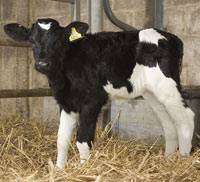Dairy Event 2009: Making the most of dairy bull calves

Bull calves from the dairy herd may traditionally have been seen as lower priority and a waste product, but with a reduction in the size of the national suckler herd resulting in a rising demand, and prices recently exceeding £100, focussed attention is needed to make the most of a valuable animal.
If dairy bull calves are fed properly and looked after correctly they can make a margin, and getting them off to the best start is vital for this, according to EBLEX beef and sheep scientist, Liz Genever.
“Getting enough colostrum in to bull calves is vital as it’s key to helping avoid poor health and low growth rates,” she says.
But, because a calf’s gut can only absorb colostrum between the first three and 24 hours of life, feeding good-quality colostrum at the right time and the right quantity is essential, says Dr Genever.
“Calves fed three litres of colostrum over two feeds within three to six hours of birth should be sufficient. A good quality colostrum should consist of 5.1% fat, 16.4% protein and high levels of vitamin A, D and E.”
But it is also important that these animals are incorporated in to a health plan, as this can potentially prevent large increases in vet and med costs, save on labour and maintain efficient growth performance, adds Dr Genever.
“Calf pneumonia can increase costs by £43-£84 a head and vaccinations can be given from two to four weeks of age. Coccidiosis and BVD are also things to be aware of.”
But, while good rearing practices are vital in getting calves to their target growth rates of 100-125kg at 12 weeks old, genetics is just as important to ensure a good bull calf is produced.
“A calf’s growth rate will vary with breeding, feeding, housing and health. And with breeding, the important things to look out for when selecting semen to get a better bull calf would be a positive calving ease score, muscularity and good growth rate, but with a birth weight EBV that’s low to negative and a low to negative gestation length,” she says.
Dr Genever also says there are advantages in using sexed semen to breed more beef crosses in the dairy herd. “Using sexed semen frees up more cows on which to use high-quality beef sires and minimises the number of pure dairy bull calves born.”
| To find out more about making the most of dairy bull calves in your herd, EBLEX will be offering best practice advice for dairy producers wanting to supply dairy bull calves in to the beef supply chain. It will also be offering demonstrations and information on using EBVs when selecting beef bulls; calf rearing and grading cull cows. The beef exhibition will also be attended by breed societies including Montbeliarde, MRI, Hereford, Simmental, Longhorn and Salers. |
|---|
Goats
Practical demonstrations will also be held on both days in the commercial goat exhibition with presentations and practical demonstrations on AI, milking and foot trimming, together with advice on feeding and genetics.
Commercial goat exhibition timetable –
- 10.45 Meet the goat farmer – Nick Brandon, Upper Enson Farm
- 11:30 Automation in the milking of commercial goats – Fullwood
- 12:15 Goat Feeding – KW Alternative Feeds
- 1:00 Raising kids for yield, butterfat and protein – Dreda Randall, Monach Herd
- 1:50-3:30 Health and welfare issue: Hoof trimming demonstration; The work of the British Goat Society
- 2:10 Current health and welfare concerns in the commercial goat sector
- 2:40 Do it yourself AI – Christine Ball, BGS
- 3:00 Crossgates Animal Health
- 3:30 Meat Goats – Boer Goat Society
Click here for more on the Dairy Event and Livestock Show 2009
